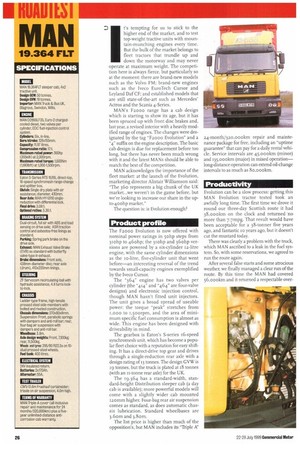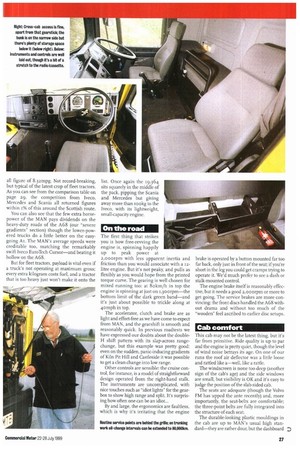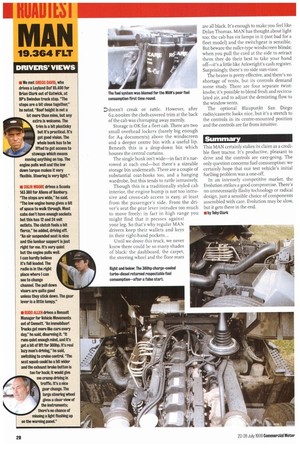s tempting for us to stick to the higher end
Page 28

Page 29

Page 30

If you've noticed an error in this article please click here to report it so we can fix it.
of the market, and to test top-weight tractive units with mountain-munching engines every time. But the bulk of the market belongs to fleet tractors that trundle up and down the motorway and may never operate at maximum weight. The competition here is always fierce, but particularly so at the moment: there are brand-new models such as the Volvo FM; brand-new engines such as the Iveco EuroTech Cursor and Leyland Daf CF; and established models that are still state-of-the-art such as Mercedes' Ac-tros and the Scania 4-Series.
MAN's F2000 range has a cab design which is starting to show its age, but it has been spruced up with front disc brakes and, last year, a revised interior with a heavily modified range of engines. The changes were designated by the tag "F2000 Evolution" and a "4" suffix on the engine description. The basic cab design is due for replacement before too long, but there has never been much wrong with it and the latest MA Ns should be able to match the best of the competition.
MAN acknowledges the importance of the fleet market: at the launch of the Evolution, marketing director Alistair Williamson said: "The 360 represents a big chunk of the UK market...we weren't in the game before, but we're looking to increase our share in the upto-400hp market."
The question is: is Evolution enough?
Product profile
The F2000 Evolution is now offered with nominal power ratings in 5ohp steps from 3rohp to 46 ohp; the 3rohp and 36 ohp versions are powered by a six-cylinder 12-litre engine, with the same cylinder dimensions as the so-litre, five-cylinder unit that went before—an interesting reversal of the trend towards small-capacity engines exemplified by the Iveco Cursor.
The "364" engine has two valves per cylinder (the "414" and "464" are four-valve designs) and electronic injection control, though MAN hasn't fitted unit injectors. The unit gives a broad spread of useable power: the torque "peak" stretches from ',coo to 1,500rpm, and the area of minimum specific fuel consumption is almost as wide. This engine has been designed with driveability in mind.
The gearbox is Eaton's S-series r6-speed synchromesh unit, which has become a popular fleet choice with a reputation for easy shifting. It has a direct-drive top gear and drives through a single-reduction rear axle with a design rating of 53 tonnes. The design GVW is 19 tonnes, but the truck is plated at 18 tonnes (with an it-tonne rear axle) for the UK.
The 19.364 has a standard-width, standard-height Distribution sleeper cab (a day cab is available); more powerful models will come with a slightly wider cab mounted
omm higher. Four-bag rear air suspension comes as standard, as does automatic chassis lubrication. Standard wheelbases are 3.6om and 3.8orn.
The list price is higher than much of the opposition's, but MAN includes its "Triple A"
24-month/32o,000km repair and maintenance package for free, induding an "uptime guarantee" that can pay for a daily rental vehicle. Service intervals are 45,000km (minor) and 135,00okm (major) in mixed operation— long-distance operation can extend oil-change intervals to as much as 8o,000lcm.
Productivity
Evolution can be a slow process: getting this MAN Evolution tractor tested took an awfully long time. The first time we drove it round our three-day Scottish route it had 38,000km on the clock and returned no more than 7.7mpg. That result would have been acceptable for a 38-ton ner five years ago, and fantastic io years ago, but it doesn't cut the mustard today.
There was clearly a problem with the truck, which MAN ascribed to a leak in the fuel system. So, with some reservations, we agreed to run the route again.
After several false starts and some atrocious weather, we finally managed a clear run of the route. By this time the MAN had covered 56,000km and it returned a respectable over
all figure of 8.32mpg. Not record-breaking, but typical of the latest crop of fleet tractors. As you can see from the comparison table on page 29, the competition from Iveco, Mercedes and Scania all returned figures within r% of this around the Scottish route.
You can also see that the few extra horsepower of the MAN pays dividends on the heavy-duty roads of the A68 (our "severe gradients" section) though the lower-powered trucks do a little better on the easygoing AI The MAN's average speeds were creditable too, matching the remarkably swift lveco EuroTech Cursor—and beating it hollow on the A68.
But for fleet tractors, payload is vital even if a truck's not operating at maximum gross; every extra kilogram costs fuel, and a tractor tha t is too heavy just won't make it onto the
list. Once again the 19.364 sits squarely in the middle of the pack, pipping the Scania and Mercedes but giving away more than rookg to the Iveco, with its lightweight, small-capacity engine.
On the road
The first thing that strikes you is how free-revving the engine is, spinning happily up to peak power at 2,000rpm with less apparent inertia and friction than you would associate with a 12litre engine. But it's not peaky, and pulls as flexibly as you would hope from the printed torque curve. The gearing is well chosen for mixed running too: at 8okm/h in top the engine is spinning at just on L3oorpm—the bottom limit of the dark green band—and it's just about possible to trickle along at 40mph in top.
The accelerator, clutch and brake are as light and effort-free as we have come to expect from MAN, and the gearshift is smooth and reasonably quick. In previous roadtests we have expressed our doubts about the doubleH shift pattern with its slap-across rangechange, but this example was pretty good: even on the sudden, panic-inducing gradients of Kiln Pit Hill and Castleside it was possible to get a clean change into low range.
Other controls are sensible: the cruise control, for instance, is a model of straightforward design operated from the right-hand stalk. The instruments are uncomplicated, with nice touches such as "idiot lights" for the gearbox to show high range and split. It's surprising how often one can be an idiot...
By and large, the ergonomics are faultless, which is why it's irritating that the engine brake is operated by a button mounted far too far back, only just in front of the seat; if you're short in the leg you could get cramps trying to operate it. We'd much prefer to see a dash or stalk-mounted control
The engine brake itself is reasonably effective, but it needs a good 2,000rpm or more to get going. The service brakes are more convincing: the front discs handled the A68 without drama and without too much of the "wooden" feel ascribed to earlier disc setups.
Cab comfort
This cab may not be the latest thing, but it's far from primitive. Ride quality is up to par and the engine is pretty quiet, though the level of wind noise betrays its age. On one of our runs the roof air deflector was a little loose and rattled like a—well, like a rattle.
The windscreen is none too deep (another sign of the cab's age) and the side windows are small, but visibility is OK and it's easy to judge the position of the slab-sided cab.
The seats are adequate (though the Volvo FM has upped the ante recently) and, more importantly, the seat-belts are comfortable; the three-point belts are fully integrated into the structure of each seat.
The durable-looking plastic mouldings in the cab are up to MAN's usual high standard—they are rather dour, but the dashboard
doesn't creak or rattle. However, after 62„000km the cloth-covered trim at the back of the cab was chirruping away merrily.
Storage is OK for a fleet cab. There are two small overhead lockers (barely big enough for A4 documents) above the windscreen and a deeper centre bin with a useful lip Beneath this is a drop-down bin which houses the central curtains.
The single bunk isn't wide—in fact it's narrowed at each end—but there's a sizeable storage bin underneath. There are a couple of substantial coat-hooks too, and a hanging wardrobe, but this tends to rattle intrusively.
Though this is a traditionally styled cab interior, the engine hump is not too intrusive and cross-cab access is easy, at least from the passenger's side. From the driver's seat the gear lever intrudes too much to move freely; in fact in high range you might find that it presses against your leg. So that's why regular MAN drivers keep their wallets and keys in their right-hand pockets...
Until we drove this truck, we never knew there could be so many shades of black: the dashboard, the carpet, the steering wheel and the floor mats
are all black. It's enough to make you feel like Dylan Thomas. MAN has thought about light too; the cab has six lamps in it (not bad for a fleet model) and the switchgear is sensible. But beware the roller-type windscreen blinds: when you pull the cord at the side to retract them they do their best to take your hand off—it's a little like Arlcwright's cash register. Surprisingly, there's no side sun-visor.
The heater is pretty effective, and there's no shortage of vents, but its controls demand some study. There are four separate twistknobs; it's possible to blend fresh and recirculated air, and to adjust the demisting flow to the window vents.
The optional Blaupunkt San Diego radio/cassette looks nice, but it's a stretch to the controls in its centre-mounted position and the controls are far from intuitive.
Summary
This MAN certainly stakes its claim as a credible fleet tractor. It's productive, pleasant to drive and the controls are easy-going. The only question concerns fuel consumption: we certainly hope that our test vehicle's initial fuelling problem was a one-off.
In an intensely competitive market, the Evolution strikes a good compromise. There's no unnecessarily flashy technology or radical design, just a sensible choice of components assembled with care. Evolution may be slow, but it gets there in the end.








































































































